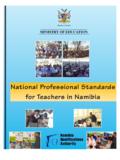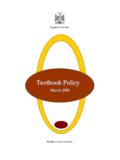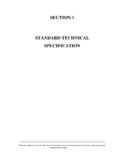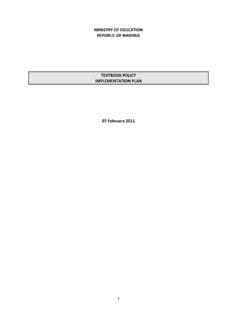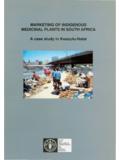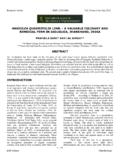Transcription of MCA Namibia Agriculture Project Description
1 MCA Namibia Agriculture Project Description April 2009. MCA Namibia Agriculture Project Description The MCA Namibia Programme is funded by the US Government through the Millennium Challenge Corporation 1. MCA Namibia Agriculture Project Description April 2009. Table of Contents 1. Introduction 4. 2. Project Description and Cost 6. 3. Activity 1: Land Access and Management 7. Sub-Activity 1: Communal Land Support 8. Sub-Activity 2 : Community-Based Rangeland and Livestock Management (CBRLM) 9. Sub-Activity 3: Environmental & Social Assessment 10. 4. Activity 2: Livestock Support 11. Sub-Activity 1: Veterinary Infrastructure Support 11. Sub-Activity 2: Livestock Traceability System 12. Sub-Activity 3: Livestock Market Efficiency Fund 13. Sub-Activity 4: Environmental Assessment 14.
2 5. Activity 3: Indigenous Natural Products Development 14. Sub-Activity 1: PPO Capacity Building 15. Sub-Activity 2: INP Innovation Facility 15. Sub-Activity 3: Market Information Delivery 15. Sub-Activity 4: Environment Impact / Gender Assessment 16. Annex 1: Conditions Precedent for the Agricultural Project of the MCA Namibia Programme 17. Annex 2: Map of Project Localities and Interventions 19. The MCA Namibia Programme is funded by the US Government through the Millennium Challenge Corporation 2. MCA Namibia Agriculture Project Description April 2009. Abbreviations CBNRM Community-Based Natural Resource Management CBRLM Community-Based Rangeland and Livestock Management CLRA Communal Land Reform Act CIF Compact Implementation Funding CITES Convention on International Trade of Endangered Species CLB Communal Land Board DFS Disease Free Status DVS Directorate Veterinary Services EIA Environmental Impact Assessment EMP Environmental Management Plan ESA Environmental and Social Assessment ETSIP Education and Training Sector Improvement Programme FAN Farm Assured Namibian Meat FMD Foot and Mouth Disease GDP Gross Domestic Product GRN Government of the Republic of Namibia HIV/Aids Human Immunodeficiency Virus INP Indigenous Natural Products IPTT Indigenous Plant Task Team LSU Large Stock Unit MAWF Ministry of
3 Agriculture , Water and Forestry MCA Millennium Challenge Account MCC Millennium Challenge Corporation MLR Ministry of Lands and Resettlement NBRI National Botanical Research Institute NCA Northern Communal Areas NGO Non Government Organizations NRMPAS National Rangeland Management Policy and Strategy PIF Promoting Indigenous Fruit PPO Primary Producer Organizations SVO State Veterinary Office TA Traditional Authority USA United States of America VCF Veterinary Cordon Fence The MCA Namibia Programme is funded by the US Government through the Millennium Challenge Corporation 3. MCA Namibia Agriculture Project Description April 2009. MCA Namibia Agriculture Project Description 1. Introduction The Millennium Challenge Account (MCA) Namibia Compact, providing grant funding for public investments in Education, Tourism and Agriculture (livestock and indigenous natural products), was signed on 28 July 2008 between the Republic of Namibia and the US.
4 Government, acting through the Millennium Challenge Corporation (MCC). An amount of US$ million will be available for development in the target sectors, over and above current Government allocations and assistance from other development partners. MCA Namibia , which is a Project implementation unit working under the auspices of the National Planning Commission, is implementing the Programme ( ). In Education, the Programme seeks to bring the quality of the work force closer to the requirements of industry and the labour market at large. The MCA Namibia Education Project contributes to Education and Training Sector Improvement Programme (ETSIP). It aims to improve the competency and knowledge of young Namibians by supporting new and innovative methods of learning in addition to the more traditional approaches to education and improve physical infrastructure for learning in schools, regional study and resource centres and Community Based Skills Development Centres.
5 Namibia is the first MCC country that will benefit from a Tourism Project . Consistent with Namibia 's national development strategies, the GRN aims to develop one of its fastest growing export industries with its focus on tourism. The MCA Namibia Programme seeks to address the following three obstacles to more rapid growth in the tourism industry and to greater participation by Namibia 's rural communities in the tourism sector. The Etosha National Park, the jewel that attracts tourists to Namibia , is not fully developed in terms of its tourism potential and faces management challenges relative to competing regional parks. Namibia is relatively unknown as a tourism destination with little diversification of source markets for long-haul international tourists and low levels of private investment on communal land due to high transaction costs and difficulty in securing long-term access to land limit benefit streams to Namibia 's formerly disadvantaged communities.
6 The Livestock Activity seeks to bring the marketing opportunities for farmers who live north of the Veterinary Cordon Fence closer to the opportunities farmers enjoy south of the Fence. The focus will be on improving veterinary services aimed at obtaining animal disease-free status for the Northern Communal Areas (NCA) in order to gain access to international markets. The accompanying public investment in rangeland management will improve access to grazing and farming practices. The overall objective is to increase the farmers'. cash income derived from large and small-stock farming in the NCA. The MCA Namibia Programme is funded by the US Government through the Millennium Challenge Corporation 4. MCA Namibia Agriculture Project Description April 2009. Comprising 11% of GDP and earning over 25% of export receipts, Namibia 's Agriculture sector supports approximately 70% of Namibia 's population with income, subsistence and employment, particularly in the northern communal areas (NCAs) where 65% of nation's poor population resides.
7 Although livelihood strategies in the NCAs vary amongst regions, a majority of households rely on a range of natural resources, such as rangeland for livestock rearing and harvesting of natural plants. The Communal Land Management system in the NCAs is characterized by open community access to grazing land, which combined with increased human and animal populations, has led to poor rangeland management, over-grazing, and severe degradation of rangeland resources. Intimately related to the declining conditions of rangelands in the NCAs is the poorly-functioning communal land tenure system and associated institutions. The land tenure system restricts private ownership of communal lands and thereby individual rights (customary rights and rights of leasehold). However, individual farmers have been allocated rights under customary systems to fence off portions of land resulting in the gradual shrinkage of common grazing areas, which in turn is detrimental to sustained livelihoods of poor households.
8 Although the Communal Land Reform Act of 2002 attempted to address these problems, the Act remains poorly understood by the general population and by the land administration institutions, including chiefs, village headmen, Traditional Authorities (TAS's), and the Communal Land Boards (CLB's) that were created under the Act. In addition, these institutions have been under-resourced, constraining the enforcement of the provisions of the Act, and in some cases, resulting in the unauthorized fencing off of large tracts of land. The partial implementation of the Act has created an environment in the NCAs that discourages investment and economic opportunities within the agricultural sector. A unique physical feature of the Namibian livestock industry is the Veterinary Cordon Fence or Red Line that runs from East to West along the southern boundary of the NCA.
9 The fence was constructed in the early 1960s to control the spread of animal diseases from the northern endemic area to the southern Foot and Mouth Disease (FMD) free area. South of the fence, about 4,000 livestock commercial farmers (managing approximately 52% of the national herd) and 65 000 communal farmers benefit from disease free status (DFS) and have access to market opportunities in South Africa, Europe and possibly the USA in the near future. The 115,000 livestock owners/households north of the fence own 48% of the national herd and do not enjoy the benefits of DFS. To market livestock, farmers must operate under compliance with FMD regulations which currently represents sizeable costs and efficiency losses, thereby compounding other production related constraints faced by the livestock farmers in the NCA.
10 Livestock farming involves nearly 60% of the households in the NCAs, and approximately 40% of the region's poor own cattle. Livestock productivity is constrained by a lack of flexible and efficient market outlets and a poorly-functioning communal land system. Given the lack of disease free status in the NCAs and limited market access, farmers face high costs in the formal marketing of animals. Poor market incentives, combined with the open access grazing systems, lead to overstocking of rangelands, degradation of the resource base, and consequently poor livestock nutrition and productivity. The estimated average off-take rate The MCA Namibia Programme is funded by the US Government through the Millennium Challenge Corporation 5. MCA Namibia Agriculture Project Description April 2009.

